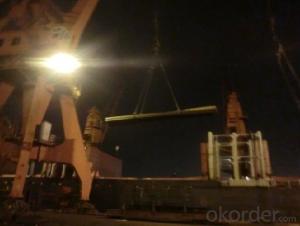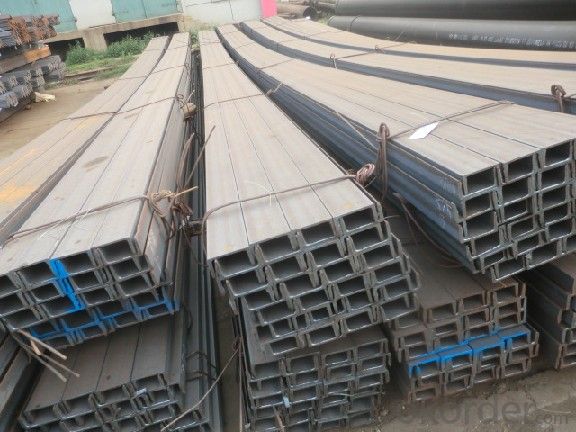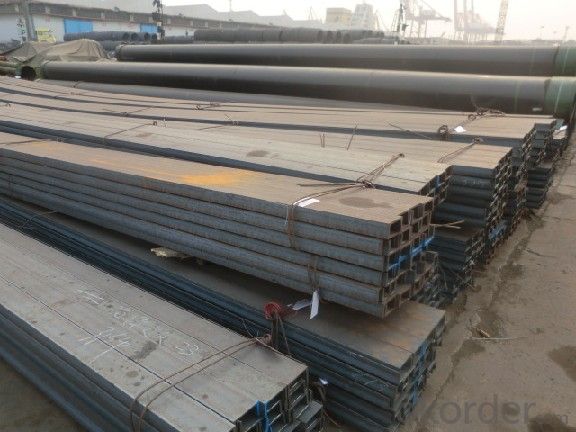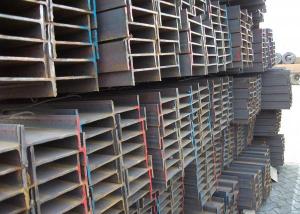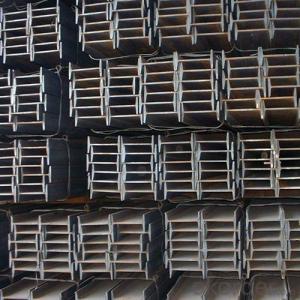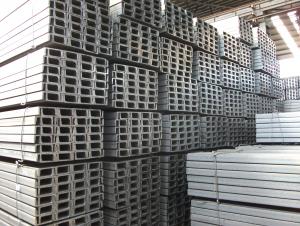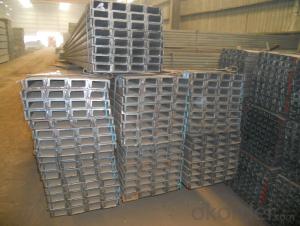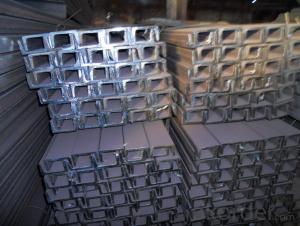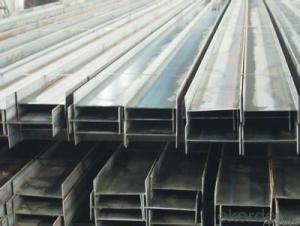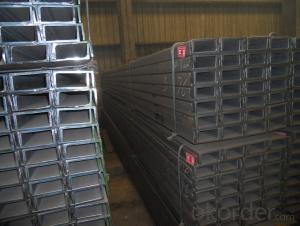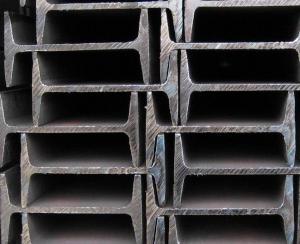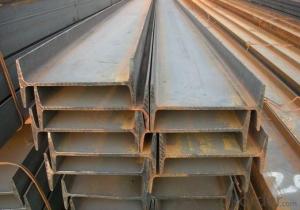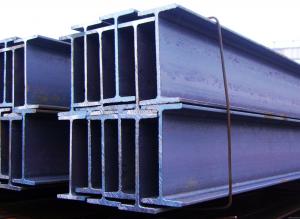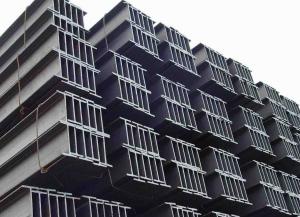Hot Rolled Steel U-Channel with Many Standard
- Loading Port:
- Tianjin
- Payment Terms:
- TT OR LC
- Min Order Qty:
- 20 m.t.
- Supply Capability:
- 1000 m.t./month
OKorder Service Pledge
OKorder Financial Service
You Might Also Like
Product Description:
OKorder is offering Hot Rolled Steel U-Channel at great prices with worldwide shipping. Our supplier is a world-class manufacturer of steel, with our products utilized the world over. OKorder annually supplies products to European, North American and Asian markets. We provide quotations within 24 hours of receiving an inquiry and guarantee competitive prices.
Product Applications:
Hot Rolled Steel U-Channel can be applied to construction of warehouses, workshops, sport stadiums and car parks etc.The hot rolled channel steel belongs to carbon structural steel which is applied to in the field of construction and machinery.In details, the hot rolled channel steel is usually used for arch-itechtural structure, and they could be welded in order to support or hang a vari-ety of facilities. They are also usually used in combination with I beam. Generally,the hot rolled channel steel we supply must possess perfect welding property, riveting property and mechanical property and so on.
Product Advantages:
OKorder's Hot Rolled Steel U-Channel are durable, strong, and resist corrosion.
Main Product Features:
· Premium quality
· Prompt delivery & seaworthy packing (30 days after receiving deposit)
· Corrosion resistance
· Can be recycled and reused
· Mill test certification
· Professional Service
· Competitive pricing
Product Specifications:
We supply high quality MS Channel at reasonable price, including Chinese standard, Japanese standard and so on.
Standard | GB/JIS |
Material Grade | Q235,SS400 |
Technique: | Hot Rolled |
Sizes as per chinese standard: | 50*37*4.5mm - 300*89*11.5mm |
Sizes as per japanese standard: | 50*25*3mm – 200*80*7.5mm |
Length: | 6meter, 9meter, 12meter |
Note: 1.we are also competent to provide our customers other MS Channel based on other sizes according to customer’s requirements.
2. The length of our ms channel could be cut into other meters as per customer’s requirements. For example, the channel in 6meters could be cut into 5.8meters in order to be fit in the 20ft container.
FAQ:
Q1: Why buy Materials & Equipment from OKorder.com?
A1: All products offered byOKorder.com are carefully selected from China's most reliable manufacturing enterprises. Through its ISO certifications, OKorder.com adheres to the highest standards and a commitment to supply chain safety and customer satisfaction.
Q2: How do we guarantee the quality of our products?
A2: We have established an advanced quality management system which conducts strict quality tests at every step, from raw materials to the final product. At the same time, we provide extensive follow-up service assurances as required.
Q3: How soon can we receive the product after purchase?
A3: Within three days of placing an order, we will begin production. The specific shipping date is dependent upon international and government factors, but is typically 7 to 10 workdays.
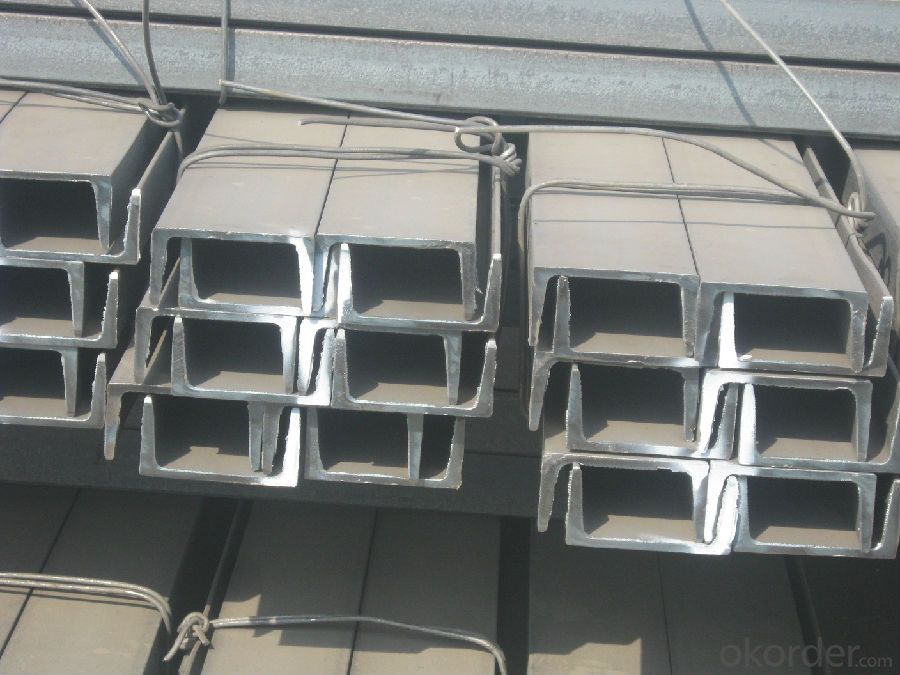
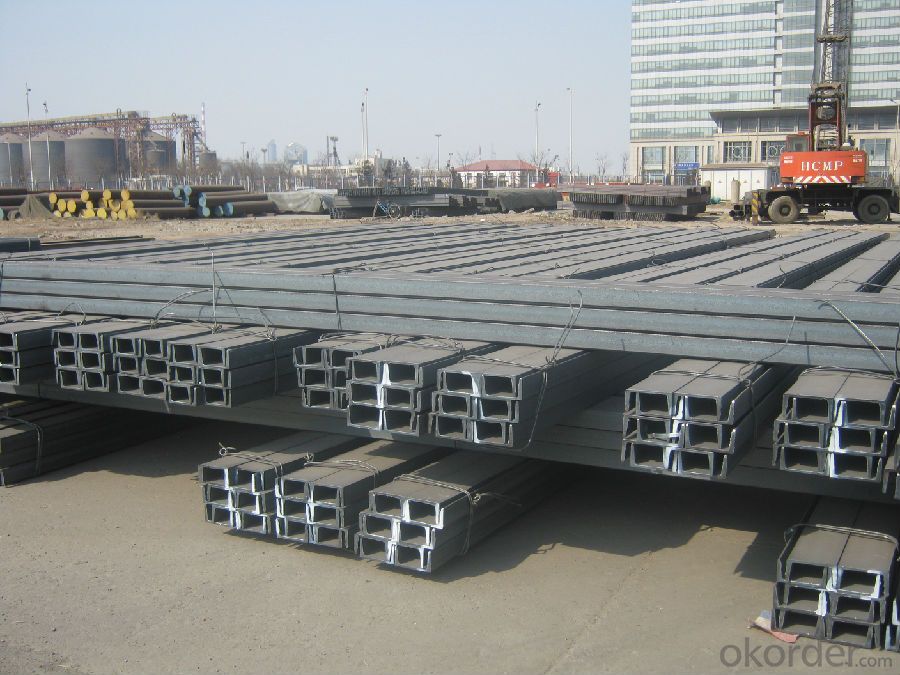
- Q: Can steel I-beams be used in theater stage construction?
- Yes, steel I-beams can be used in theater stage construction. Steel I-beams provide strong structural support, making them suitable for use in large-scale theater stages and platforms. They can withstand heavy loads, such as sets, props, and equipment, ensuring the safety and stability of the stage. Additionally, steel I-beams can be easily customized and fabricated to meet specific design requirements, allowing for flexibility in stage construction. Their durability and long lifespan make them a popular choice in theater stage construction, as they can withstand the demands of frequent use and provide a solid foundation for various performances and productions.
- Q: Can steel I-beams be used for airport terminal structures?
- Indeed, airport terminal structures can utilize steel I-beams. These beams are frequently employed in construction owing to their robustness, resilience, and capacity to bear substantial loads. They can serve as the skeletal foundation for an airport terminal, furnishing essential structural reinforcement for the edifice. Furthermore, steel I-beams can be conveniently manufactured, enabling efficient construction and tailored adaptations to suit the terminal's unique design prerequisites. By incorporating steel I-beams into airport terminal structures, the requisite strength and stability are assured to accommodate the vast span and height demands of such establishments, while also permitting design flexibility and future expansions.
- Q: Can Steel I-Beams be used for overhead cranes?
- Yes, Steel I-Beams can be used for overhead cranes. Steel I-Beams are commonly used as structural elements in the construction industry due to their strength and load-bearing capabilities. These beams are designed to provide support and stability in various applications, including overhead crane systems. Overhead cranes require durable and sturdy support structures to handle heavy loads and ensure safe operation. Steel I-Beams are ideal for this purpose, as they offer high strength-to-weight ratio and are capable of withstanding the dynamic forces exerted by the crane. The design and specifications of the Steel I-Beams for overhead cranes depend on factors such as the weight capacity of the crane, the span or length of the crane runway, and the type of load being lifted. The beams need to be properly sized and engineered to handle the specific requirements of the crane system. Additionally, Steel I-Beams can be easily connected and joined to create a strong and rigid framework for the crane system. They can also be integrated with other components such as trolleys, hoists, and bridge girders to form a complete overhead crane setup. It is important to ensure that the Steel I-Beams used for overhead cranes are of high quality and meet the necessary standards and codes for structural integrity and safety. Regular inspections and maintenance should also be conducted to ensure the continued reliability and performance of the crane system.
- Q: What are the factors to consider when calculating load capacity for steel I-beams?
- When calculating the load capacity for steel I-beams, there are several factors that need to be considered. These include the material strength, beam size and shape, beam length, and the type of load it will be subjected to. Additionally, factors such as the beam's support conditions, deflection limits, and safety factors also play a crucial role in determining the load capacity.
- Q: What are the potential hazards associated with steel I-beam installation?
- There are several potential hazards associated with steel I-beam installation that need to be taken into consideration. Firstly, the sheer weight of steel I-beams can pose a significant risk if not handled properly. These beams can weigh several hundred pounds or more, and if they are not properly secured during installation, they can fall and cause serious injuries or even fatalities to workers or bystanders. It is important to use appropriate lifting equipment and follow proper safety protocols to ensure the safe handling and installation of steel I-beams. Secondly, the installation process itself can be hazardous. Steel I-beams are often installed at elevated heights, which can increase the risk of falls. Workers must be equipped with fall protection gear, such as harnesses and safety nets, and proper scaffolding or platforms should be used to provide a stable work surface. Additionally, workers should be trained on proper lifting techniques and be aware of potential pinch points or crush hazards during installation. Another hazard associated with steel I-beam installation is the risk of structural collapse. If the beams are not properly aligned, secured, or supported, it can lead to structural failure, which can be catastrophic. It is crucial to have a qualified engineer or structural specialist oversee the installation process to ensure that all load-bearing requirements are met and that the beams are installed correctly. Lastly, there may be additional hazards related to the specific environment in which the steel I-beams are being installed. For example, if the installation is taking place in a confined space or in an area with limited ventilation, there may be risks associated with poor air quality or exposure to hazardous substances. It is important to assess and mitigate these potential hazards before beginning the installation process. Overall, the potential hazards associated with steel I-beam installation highlight the need for proper planning, training, and adherence to safety protocols. By following best practices and ensuring that all necessary safety measures are in place, the risks can be minimized, and the installation process can be completed safely and efficiently.
- Q: How are steel I-beams measured?
- Steel I-beams are typically measured by their height, width, and weight per foot. The height refers to the vertical distance between the top and bottom flanges, while the width represents the horizontal distance between the flanges. The weight per foot indicates the mass of the beam per linear foot. These measurements help determine the structural properties and load-bearing capacity of the I-beam.
- Q: Can steel I-beams be used for temporary structures?
- Indeed, steel I-beams serve as a viable option for temporary structures. Renowned for their robustness, longevity, and adaptability, steel I-beams are favored in the realm of temporary structures. They offer exceptional structural reinforcement, rendering them suitable for a diverse array of applications, including temporary bridges, scaffolding, shoring, and temporary event structures. The load-bearing capacity of steel I-beams is widely acknowledged, enabling them to securely bear heavy loads. Their resistance to fire, pests, and corrosion further enhances their suitability for prolonged outdoor utilization. Furthermore, steel I-beams boast effortless assembly and disassembly, making them highly convenient for temporary structures that necessitate relocation or dismantling within a designated timeframe. The versatility of steel I-beams permits the creation of various temporary structures, ranging from rudimentary shelters or stages to elaborate warehouses or exhibition halls. They can also be combined with other materials, such as plywood or fabric, to fabricate temporary structures tailored to specific requirements. In conclusion, steel I-beams stand as a dependable and pragmatic choice for temporary structures, offering strength, durability, and adaptability.
- Q: Are steel I-beams resistant to impact or blast loads?
- Steel I-beams are generally resistant to impact and blast loads due to their high strength and structural integrity. However, the level of resistance can vary depending on various factors such as the size and quality of the beam, the intensity of the impact or blast, and the overall design of the structure. In some cases, additional measures such as reinforcing the beams or implementing specialized blast-resistant designs may be necessary to enhance their resistance capabilities.
- Q: Are steel I-beams affected by vibrations or oscillations?
- Yes, steel I-beams can be affected by vibrations or oscillations. Like any other material, steel has a natural frequency at which it tends to vibrate. If external forces or loads are applied to the I-beam that are close to or match its natural frequency, the I-beam can experience resonant vibrations. Resonance can lead to excessive vibrations, which can cause fatigue and ultimately compromise the structural integrity of the steel I-beam. Therefore, it is important to consider the potential for vibrations or oscillations when designing and using steel I-beams to ensure their long-term stability and safety.
- Q: Is the material of steel I-beam manganese steel?
- H type I-beam is also called wide flange I-beam, HW, HM, HN originated from European standards, HEB is the German standard of I-beam, of which HW, HN I-beam has been widely used in our country and production. HEA HEB HEM will be seen on many German designs and is hard to buy on the domestic market. In the domestic steel structure engineering, if the quantity is few, then may use the specification steel plate to carry on the welding splicing. In the case of large quantities, it is usually considered to use mechanical properties comparable to those of HW and HN steel.HW is mainly used for steel reinforced concrete frame column steel column, also known as rigid steel column; in steel structure is mainly used for the columnHM steel height and flange width ratio of about 1.33~~1.75, mainly in the steel structure used as steel frame column, in the frame structure under dynamic load frame frame, for example: equipment platformHN steel height and flange width ratio greater than or equal to 2; used mainly for beamsThe use of ordinary I-beam is equivalent to HN steel;
Send your message to us
Hot Rolled Steel U-Channel with Many Standard
- Loading Port:
- Tianjin
- Payment Terms:
- TT OR LC
- Min Order Qty:
- 20 m.t.
- Supply Capability:
- 1000 m.t./month
OKorder Service Pledge
OKorder Financial Service
Similar products
Hot products
Hot Searches
Related keywords
